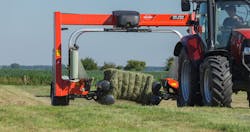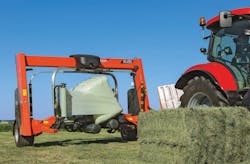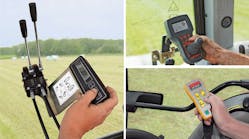Wrapping silage bales in the field preserves feed quality, prevents crop damage or loss, and simplifies handling. Until now, bales have been loaded into and unloaded from bale wrapping machines manually. The Kuhn SW 4014 bale wrapper combines automated electronic controls with hydraulic power to eliminate manual handling, speeding field operations for increased capacity and ensuring consistent quality. The SW 4014 is designed and manufactured by Kuhn North America, Brodhead, Wis.
Hydraulic cylinders retract the width of the SW 4014 to only 98 in., making it road-ready to move from one field to another.
For road transport, hydraulic cylinders retract the machine’s sliding frame that contains the wrapping arms to an overall width of only 8 ft 2in. (2.5 m). Upon arriving at the field, the operator simply pushes a button, and the wrapper’s width extends to its operational width of 13 ft. (4 m), providing greater stability and enabling drive-through operation over rows of hay bales. The machine’s satellite receiver also goes to the zero position, and the loading arms move to their pre-load position ready to begin the process, which includes loading, wrapping and unloading bales.
At its working width of 13 ft, the SW 4014 moves with stability through the field, loading, wrapping, and unloading bales while the tractor stays on the move.
Award-Winning Design
Kuhn’s autoload function was awarded the American Society of Agricultural and Biological Engineers AE50 Award for innovations in its field and is based on Category II Laser technology. During operation, a laser sensor in the top cover at the front of the machine, scans the area ahead of it at ground level until it senses the edge of a bale. As it continues sensing, it detects the end of the bale, allowing the bale length to be calculated by counting pulses from a wheel sensor on the left wheel. Once the laser sensor detects the bale edge and the bale length is determined, loading arms are activated at the precise time to load the bale into the center of the machine’s rollers. With the bale in position, the wrapping arms rotate around the bale, encasing it completely in film before placing it back in the field. While this is occurring, the operator can continue driving ahead to the next bale, making it a continuous operation.
“In the past, the driver had to look back and estimate when the bale was centered in the machine,” explained Bart deVries, Kuhn product and marketing manager. “Now, all the driver has to do is drive up and the machine is doing all the rest. It’s non-stop wrapping at up to 3 km/hr as it picks up and wraps one bale after another in the field. Before, you had to stop. Now it’s fully automated.”
Hydraulic-driven rollers grab a bale, lift it, and rotate it—clockwise, in this view. Simultaneously, loading arms rotate clockwise (as viewed from above) to completely wrap the bale. Finally, hydraulic cylinders pull the two roller assemblies apart and gently set the wrapped bale back onto the field.
Hydraulics and Controls
Kuhn engineers selected hydraulic operation for all major machine functions because they felt it was the most cost-efficient way to achieve precise control of the complex motions required throughout its operation. It also provides greater durability and stands up better in the machine’s working environment than other alternatives. Every operation is computer-activated and performed hydraulically. Major hydraulic components include a seven-section main valve block, with three proportional and four on-off valves.
The hydraulic system can also incorporate an optional load-sensing pump, two motors that drive the loading rollers, a cylinder that moves the sliding frame from transport to field configuration, and a motor that drives positioning of the satellite receiver. A hydraulic brake is used to stop the satellite receiver, hold its position, and also help control the two rollers and loading arms.
Hydraulic power normally comes from the towing tractor’s hydraulic system and requires flow rates from 11 to 16 gpm (45 to 60 lpm) for peak efficiency and productivity. A self-contained hydraulic system driven from the tractor’s PTO is optional. This version isolates the SW 4014’s hydraulic system to allow independent control of engine speed and ground speed and prevent cross-contamination of hydraulic fluid. It also conserves fuel because the tractor’s engine can operate at a lower speed with the PTO version.
The standard control for the SW 4014, shown at left, consists of two mechanical control levers and an electronic counter with auto-stop function. A multifunctional joystick, upper-right, is offered as a convenient option, as is a wireless remote control, lower-right.
Machine Controls
Two different control systems are available for the SW 4014, depending the specific model chosen and driver preferences. A manual version is controlled by cable levers and comes standard with the bale-and-wrap counter and auto-stop function. The bale-and-wrap counter counts the film layers and total number of wrapped bales. The auto-stop function automatically stops the wrapping table and satellite once the total number of film layers have been machine.
A computer-controlled version uses a control box that provides all the information and features for a fully automatic wrapping process. A multi-function joystick automatically steers bale discharge and controls other direct functions. An optional remote-control system is also available for certain wrappers.
The SW 4014 is compatible with ISOBUS, an international communication protocol for the agriculture industry based on the SAE J1939 protocol. Once the laser, angle, and wheel sensors transmit digital data to the machine’s control system, the machine’s control activates the electrohydraulic valves that operate the loading arm cylinders, loading roller drive motors, and wrapping arm motor in the proper sequence.
Round or Rectangular
An interesting design challenge arose from the need to wrap both round and rectangular bales. A rectangular bale presents a complex software challenge because the peripheral speed of the bale should be stable in order to get a 50% or 67% overlap of the plastic wrapping film. Because the bale is not round, the speed of the loading rollers must constantly increase and decrease according to the orientation of the bale.
When a bale starts horizontally, it ends horizontally. The system’s intelligence automatically corrects the number of film layers if slip is detected between a dry bale and the rollers. If slip does occur, the system adds one or two extra rounds from the satellite and drive rollers, so the bale ends up horizontally to guarantee perfectly wrapped bales every time.
The SW 4014 is capable of wrapping large square and round bales up to 3,300 lb. without any additional equipment or mechanical adjustments. With sophisticated electronics and hydraulics, the system monitors the wrapping process and controls the film overlap continuously to ensure an optimum oxygen barrier and achieve increased silage quality.
Click here to watch a video showing the SW 4014 in action.






